- English Active

Maurice Koechlin, the Swiss who designed the Eiffel Tower
The Eiffel Tower has Swiss roots! The statement might seem a little pretentious, but there really is a Swiss connection to the famous tower – the French-Swiss engineer Maurice Koechlin.
Switzerland has a significant link to the Eiffel Tower: Maurice Koechlin may not be as renowned today as Gustave Eiffel, but he drew the first sketch for the tower and remains its true creator. His great-grandson Jean-David Koechlin reflects here on the tales he heard growing up, as well as on the story of an ancestor who was Gustave Eiffel's employee, his friend, and finally his successor.
From Mulhouse to Zurich
The story begins on the banks of the Rhine in Mulhouse, France. With the financial support of nearby Basel, the city had become one of the 19th century's key industrial hubs – its success was so phenomenal that it was dubbed 'the French Manchester'. "Everything was possible for them – they believed in progress," explains Jean-David Koechlin. When the Franco-Prussian war broke out in 1870, however, Mulhouse fell to the Prussians. A number of the great Protestant families who had helped Mulhouse flourish fled the city. This included Maurice Koechlin's family, who settled in Switzerland. Maurice's father sent his children to the Swiss Federal Institute of Technology in Zurich, one of the world's leading technical universities for engineering.
Recommended by his professor
Koechlin, who was the oldest of his siblings, decided to take up the Swiss citizenship his family held before they moved to Mulhouse. In Switzerland he studied under a brilliant professor by the name of Karl Culmann. A specialist in 'graphic statics', Culmann taught Koechlin a revolutionary method for using box girders to build remarkably tall structures. Thrilled by this Swiss expertise, the great Parisian developer Gustave Eiffel asked Culmann to recommend him a student. Koechlin was such an enthusiastic pupil that Culmann suggested him to Eiffel.
From lofty ambitions...
In November 1879 Maurice Koechlin was hired to work for the metal construction and public works company founded by Gustave Eiffel in 1868. He soon began work on the Garabit railway viaduct in Auvergne, an audacious project that was inaugurated in 1884 and towers 122 metres above the river below. Koechlin made innovative use of bridge piers that are strikingly reminiscent of the tower he would later work on. He then worked alongside the engineer Auguste Bartholdi, a fellow Alsatian, on fine-tuning the steel framework of the Statue of Liberty in New York. In 1884 Koechlin became the head of Eiffel's engineering department at the age of 28. The Universal Exhibition in 1889 offered a chance to make a lasting impression: working alone and bolstered by his recent experience, Koechlin drew a sketch for a tower that reached the symbolic height of 1,000 feet (300 metres) – taller than any existing structure. Until then, Cologne Cathedral had been the world's tallest monument at 150 metres. Koechlin referred to his project simply as the "pylon".
"Through his trust in human intelligence he reached the apex of what was possible," says Jean-David Koechlin.
The following day Koechlin discussed the sketch with technical director Émile Nouguier. The two men presented it to Gustave Eiffel, who was less enthusiastic. While he recognised the boldness of the concept, Eiffel didn't find it aesthetically pleasing and encouraged the engineer to rethink the design. "Although he was impressed it reached 1,000 feet, Eiffel wanted other features, such as the inclusion of a large arch." So Koechlin went back to the drawing board. Together with his colleague he called on the company's head architect, Stephen Sauvestre, who hit on the ingenious idea of 'embellishing' each of the tower's levels. As well as the arch at the base of the tower, he added a large conference centre on the first floor that was never built. He also made generous use of ornamentation, placing statues of figures sounding trumpets at the corners of the tower's second level.
...to a magnificent tower
This time round, Gustave Eiffel was won over by the project. He found the tower magnificent, and even anticipated potential technical additions such as illumination and optical telegraphy. He imagined it as a beacon that would illuminate all of Paris. Throughout the rest of his life, Eiffel used the tower to conduct various experiments, for example dropping objects from different levels to test Newton's theory of gravity. Alongside Koechlin and Nouguier, Eiffel submitted a patent application 'for a new configuration allowing the construction of metal supports and pylons capable of exceeding a height of 300 metres'. Shortly afterwards he bought the patent rights from the two engineers, who each received the equivalent of 1% of the construction costs. Eiffel thus became the project's sole founding father: as a powerful and widely recognised industrialist, he alone could see the project through to its conclusion. Koechlin focused on managing the construction process: not one of the 18,038 construction elements was used without his authorisation.
From ephemeral to enduring
In January 1887 Gustave Eiffel won the competition launched for the Universal Exhibition with his project for a 300 metre-high tower. The tower was originally due to stand only for the duration of the exhibition, from 6 May to 31 October 1889. It was built in two years, two months and five days and inaugurated on 1 March 1889. Because of its success and robust deign, however, the tower endured long after the Universal Exhibition.
Friends in high places
Maurice Koechlin, who succeeded Gustave Eiffel as the head of the Eiffel construction company in 1893, didn't seem to begrudge his boss for acquiring the project. As his great-grandson, Jean-David Koechlin, explains:
There was never the slightest ill-will between Eiffel and my ancestor, who went from being his employee to his successor. The two were actually on excellent terms – they were friends. Eiffel, who was 24 years older than Koechlin, was a frequent visitor to the Swiss Riviera. I'm convinced he showed Koechlin the region, and likely also the house my great-grandfather bought and lived in towards the end of his life.
Imitations around the world
Today the Eiffel Tower is an international icon of France and a showcase for the city of Paris, as well as one of the world's most visited monuments with an entrance fee. Though none can truly match it, the tower has inspired many imitations around the world, the oldest being Blackpool Tower, which was built in 1894 in the north of England. The replica in Las Vegas is the most famous copy, but the Parisian tower has also inspired close imitations in Paris, Texas and Paris, Tennessee, as well as in Tokyo, Shenzhen and Hangzhou in China, Prague, and Slobozia in Romania.
Article originally published on L'Illustré and adapted, Marc David, on 3 November 2021
Other recent stories from this category
The world economic forum: a swiss success story, gori: from ticino to the united states, chocolate and switzerland: a story that goes way back, news from the house.
Skip to Content Skip to Main Navigation Skip to Footer Skip to Search
Chair of Structures and Structural Design
Faculties and institutions.
- You Are Here: Maurice Koechlin - The real inventor of the Eiffel tower
Faculties and Institutes
- Mathematics, Computer Science and Natural Sciences Faculty 1
- Architecture Faculty 2
- Civil Engineering Faculty 3
- Mechanical Engineering Faculty 4
- Georesources and Materials Engineering Faculty 5
- Electrical Engineering and Information Technology Faculty 6
- Arts and Humanities Faculty 7
- Business and Economics Faculty 8
- Medicine Faculty 10
Find Institute:
Institutions.
- University Library
- Center for Teaching and Learning Services
- Athletics and Recreation
- Central University Administration
- All Institutions
You Are Here:
- Construction History
Maurice Koechlin - The real inventor of the Eiffel tower
Sub-navigation.
- Publications
- Timber Construction
- Experimental Bio Materials
- Lightweight Construction
- Principles of Structural Morphology
- Industrial Buildings
- The vanished engineer
- Eine Trilogie von der Suche nach der Form statisch idealer Kuppeln
Though named after a project of Gustave Eiffel, the Eiffel Tower – symbol of Paris – has ist structural concept and form from the responsible chief engineer Maurice Koechlin.
Koechlin was an engineer of outstanding ingenuity and well-versed in the structural techniques of his time. He possessed therefor the best qualifications for evolving such technically innovative conceptions for which Eiffel and his firm were renowned.
Maurice Koechlin was born on the 8th of March 1856 in Bühl (Alsace), offspring of a calm, in the Alsace area and Switzerland living family of industrials and townsmen: the great grandfather Jean Jacques (1789 – 1875) established a foundry in Mühlhausen, which developed into a machine factory that produced steam locomotives since 1839. The father Jean Frederique (1826 – 1914) owned a spinning plant. This way Maurice learned to be familiar with the range of task of the new and upcoming industrial society, from which he chose the work as an engineer for himself.
After a visit at the Lyzeums in Mühlhausen Maurice enwrote at the technical University of Zürich and studied civil engineering. He was a student of Karl Culmann (1821 – 81), who would have great impact on his engineering career.
Karl Culmann
Culmann was the founder of graphostatics, a new method of statics the time to calculate beams and different frameworks. It is based on the visualizing forces by drawing them as vectors and calculating cutting forces through geometry. Compared to analytical procedures, where often highly complicated integrals are to be solved, graphostatics is based on simple geometrical principals. Are these used consequently complex support structures can be calculated.
Culmann tought his students the use of graphostatics with the help of examples, that were aligned for the geometrical optimization of bridge grinders. The original theories were part of his own studies. The goal was to use the cross section of bridge grinders under pressure in an optimized way – which was also a central quality of the so called “Pauli-Grinder”. This construction, which reduced the amount of used steel, was called the “grinder of equal resistance.
*** Maurice Koechlin - der eigentliche Erfinder des Eifelturms ***
Maurice Koechlin left the technical University of Zurich graduating top of his class and began to work 1877 as an engineer at the railway company „Chemin de Fer de l’Est“. Two years later he starts working for the office of Gustave Eiffel (1832 – 1923) in october of 1879. Koechlin was replacing the leading engineer Théophile Seyrig (1843 – 1923), Eiffels Partner, who had provem himself to be an extraordinary and creative Engineer. He designed the steel framework arch bridge „Maria Pia“ cross the Douro near Porto (Portugal, 1875 – 77). This construction (Image 2) brought international recognition to Eiffels firm for the first time, not only because of the exceptional technical Konzept of a 160 meter span round arch, but also because of its economical superiority: the costs of the bridge were almost 40% below the proposal of the nearest favorable provider.
It didn’t take long until others moved up to Eiffel to realize similar constructions. In this context Seyrig asked to be adequate financially included in the merchandise of his construction. Eiffel took the Occasion to terminate his partnership early and to fire Seyrig.
The Garabit viaduct
Together with Nouguier, Koechlin developed a concept and the construction of the viaduct across the Trades (1881 – 84). The steel-beam-bridge is erected across three spans and one of the first to be built after the cantilever method. This building method reflects in the construction as closed meshed lattice girders, since contrary to them, the Beam bridges by Eiffel had always been cross-struts-frameworks. Because of the lattice girders, the lower brace is evenly supported and the different local pressures caused by shifting of the beam can be handled more easily. Koechlin calculated the different loading conditions of beam and columns through impact curves. The triumph of this project was tarnished, because a winter storm destroyed the bridge during construction.
Less spectacular on technical Terms, however much brighter in its context is the structure of the statue of liberty of the United States of America (1881 – 86), which was design and calculated by Koechlin. The sculpture was a present from France to the Americans in remembrance of their independence. She was originally designed by Auguste Bartholdi, a sculptor from Alsace; Viollet-le-Duc as his consultant. After his early death in 1879 Eiffel and his firm took the project on. Analog to the column construction of the bridge, Koechlin developed a strait framework mast along which the single parts of the sculpture where hung and fastened with bars, cross- and diagonal-pieces. This sub structure was especially designed for pressure under wind power. Its shell is made from policed copperplates, that are connected though rivets and bars. After a test run in Paris in the year of 1884 the statue of liberty was erected outside the gates of New York, on Bedloe’s Island, and unveiled in 1886.
The 300-Meter-Tower
The idea of holding a world exhibition in Paris for the hundredth anniversary of the French revolution in 1889 met high approval in France. In times of defeat and economic depression this sign of confidence and upturn was needed. Beside the proposals to build a colossal statue or a monument, the planning of a high tower was considered, following the examples made in the States and England.
1881 the French engineer Sébillot developed the idea of building a „Tour de Soleil“(„sun tower“), which should enlighten the nocturnal city of Paris with the help of a certain lighting. After the French government had officially announced in May 1884 the world exhibit for the year of 1889, Sébillot designed in cooperation with the Architect Bourdais a 300-meter-high tower made form granite with enormous headlamps on the very top. Even though the project was seen rather skeptical, it was discussed publicly until the first planning competition in May of 1886.
In Spring of 1884 Maurice Koechlin and Emile Nougier had also put thought into the matter. Koechlin developed a design for a so called „Pylone de 300m de hauteur“ construction, a mast of 300-meter hight, build as a framework construction, its silhouette tapering towards the top. This complete different way of designing becomes more obvious, by looking at Koechlins sketches and comparing them to Sébillots and Bourdais, who reminds of a rather oversized and romanticized reconstruction of the seventh world wonder: the extraordinary lighthouse on the island Pharos.
Different from the bridge construction, for the towers the cross operating powers – meaning Wind – play a very important role. Again this was a possibility for Koechlin to start an Optimizationprocess, where the goal is an ideal shape of the tower based on the estimated wind power. The course of the towers pillars equals the “pressure line”, a fictive line, in which the load transfer of cross and lengthway powers all coincide. It’s similar to the moment curve of a vertical cantilever under a given wind power. In the jargon of culmanns or von Paulis teaching one would speak of “a cantilever of equal resistance”. Koechlin determinded the geometry of the world-exhibit-tower under the refined conditions and with help graphostatic methods.
When Koechlin and Nouguier presented the sketch of the pylon of 300 meter hight to Eiffel, he responded skeptically, however allowed them to continue their work. Apparently, he had an idea how to sell this rather unusual concept to the exhibition committee. He assigned the architect Sauvestre to edit Koechlins idea. Sauvestre changed the allocation of the floor stages and applicated circular structures at the tower bases. This concept Eiffel presented to the exhibition committee as a first draft and won the project for himself. This way the tower wasn’t only presented as an exhibition building, it also advertised it to be an important tool of scientific research in the area of meteorology, astronomy and aerodynamics. Koechlins initial Partner regarding the idea and construction of the Tower wasn’t mentioned at all and his was put between all the other names of participants. This exceptional construction and shape of the tower was also the main point of criticism at the time. To offend the highly-engaged project engineer, the tower was derogatively called the “Eiffeltower”. This led even more to the connection between name and tower. After a while the critic had turned into general admiration and the tower was finished in time for the exhibition, which gave Eiffel more and more the image of a brilliant engineer – however, on the cost of his employees. Even though, his successful firm is proving his entrepreneurial talent, with a great understanding of the technically possible. His behavior shows though, that his talents as an engineer weren’t as great and he tried to compensate for it by the specific takeover of others ideas.
Koechlin and Eiffel
Surely it wasn’t difficult, to differ from Eiffels extrovert personality, however, Koechlin and Eiffel could have not been more different from one another. While Eiffel lived a life in the public, Koechlin preferred to stay rather private, avoid public appearances. Although, he published many scientific pieces and a book regarding the application of graphostatics, he never enjoyed talking about them. This strong understatement surely helped him to accept, that his name was mentioned in the context of the building of the 300 meter tower, but his work was never correctly acknowledged properly and didn’t receive the adequate appreciation.
On the other Hand Koechlin was very aware, that without Eiffels personal und entrepreneurial Engagement, assignments in the quality of a 300-meter-tower would have been unachievable. This particular attitude was an important reason why the cooperation between two such different Characters did not only work very well until Eiffels death in 1923, but was also filled with high mutual respect for one another. Only in the context of the Eiffeltowers 50th anniversary the public began to wonder about the original draft and gave Koechlin more attention. It is said that during that time Koechlin made the only personal statement regarding the 300-meter-tower, in cooperation with Eiffel, in which he states: „Le père de la Tour c’est Eiffel – mais l’idée et les calculs, c’est moi.“ („The Towers father is Eiffel, but the idea and calculation were made by me”). From 1893 on, after Eiffel had stepped down, until 1940 Maurice Koechlin took over the management of the firm. His last years Kochlin lived in his house in Veytaus (Swizerland), where he passed in 1946 at the Age of ninety.
Even though, it sounds paradox: The Eiffeltower as we all know it, would have never been built if it wasn’t for Maurice Koechlin. This shape, developed following only technical aspects, had outshone its competition and fascinates us until today. It illustrates the effect of loads, similar to steel-bridge-constructions in the 19th century, the vaults by Antonio Gaudì or the rope constructions in the sixties by Frei Otto. Koechlin therefore belongs to the group of leading engineers of modern times. Nonetheless, the construction of the 300-meter-tower for the world exhibition in Paris brought mainly the Eiffels name the worldwide renommee. Still, it remains his personal and undebatable accomplishment that his concept enrichened the engineering architecture with another milestone.
Martin Trautz
last updated: 27/11/2018
- RWTH Main Page
- Faculty of Architecture
- Contact and Maps
- Site Credits
- Privacy Policy
- Accessibility Statement
Other Resources
- Gesellschaft für Bautechnikgeschichte
- TensiNet association
- International Association for Shell and Spatial Structures

- Eiffel tower
- Biographies
- Maurice Koechlin

- Inauguration
Proprietary
Inscription
Location: Paris, France
GPS : 48° 51' 30.13'' North / 2° 17' 40.13'' East
Description
Its dimensions
- Gustave Eiffel
How to visit it?
All the pages
Others landmarks
Biography of Maurice Koechlin
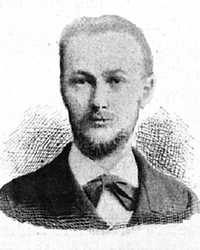
Maurice Koechlin was the head of the design office of the Eiffel companies.
Mr. Maurice Kœchlin was born in Buhl (Alsace), in 1856. After his classical studies at the College of Mulhouse, he moved to the Strasbourg Gymnasium, then he entered the Ecole Polytechnique of Zurich, a famous scientific institution that rivals Switzerland with our great school and from which he left the first. For two years he was attached to the Eastern Railways in Paris at the Technical Studies Office. He published two volumes on the applications of graphical statics in the Encyclopedia of Public Works, founded by Mr. Lechalas, Inspector General of Roads and Bridges. He is the author of a new theory on arches. For twelve years, he has collaborated actively in all major works pursued by the Eiffel House. It is he who made countless calculations, directed the studies and the execution of the drawings necessitated by the construction of the Tower. In May 1889, he received the Knight's Cross of the Legion of Honor as a reward for his collaboration with the great works undertaken by Mr. Eiffel.
In October 1889, Mr. Koechlin applied to the Swiss Federal Council for a concession for the construction and operation of a railway from Lauterbrunnen to the Jungfrau summit. The Bernese claim that the project is perfectly feasible. The planned line will consist of two parts: the first will be a narrow gauge railroad which will continue the Interlaken line at Lauterbrunnen, currently under construction, which will take the passengers to the foot of the Jungfrau; the second part will take place on the mountain; but M. Koechlin still hesitates on the mode of traction. The work will last seven years, because one will be able to operate only in the beautiful season; it will cost about 10 million. The railway will be operated during the five summer months; Engineers rely on thirty days of complete ascent per year and an average of 30,000 ascensionists. The return trip will cost 35 francs.
Biographies of the Eiffel tower
Description of the Eiffel tower
- History of art
- Artistic works
- Advertising
- Ground floor
- intermediate floor
- The 72 scientists
- Copies and replicas
- Watkin's tower
- Elevators Fives-Lille
- The tower in 1900
- Technological context
- Others projects
- Reticences of artists
- Construction
- Commmorative medal
- Renovations
- Rights of reproduction
- Prinery Le figaro
- The tower and expo
- Companies Eiffel
- Emile Nouguier
- Stephen Sauvestre
- Jean Compagnon
- Adolphe Salles
- Jean Gobert
- Edouard Lockroy
- Franz Reichelt
- Contract of concession
- Descriptives boards
- Calculation of forces
- Calculation due of weight
- Calculation due to the winds
- Calculation due to weigth of visitors
- Foundations
- Profitability
- Civil engineering
- Opening time
- To see on the tower
- Story of a visit
- Pictures of a visit
- Visitors known
- Weather observations 1889
- Weather observations 1890
- Air resistance
- Pressure of wind
- Free air pressure gauge
- Solar spectrum
- Atmospherics absorptions of radiations
- aerial navigation
- Broadcasting
- Telephotography
- Optical telegraphy
- Naturals effects
- Effects of lightning
- Oscillations of top
- Effects of climbing

Copyright 2013 - 2024 - Any reproduction prohibited without the authorization of the author. This Internet site is a private, unofficial site, resulting from the work of compilation of the works of various authors. Unless otherwise stated, the photos are the property of the webmaster. Any use of texts, photos or other elements of this website is prohibited without the consent of the webmaster. To contact him, use the link on the page credits . Documentary sources: click here . To view the site's privacy policy, please click here: Privacy Policy .
Websites of the same author: The Pyrénées-Orientales , Marguerite Duras , Wonders of the world , Roman Emperors .

Tour Eiffel
The Eiffel Tower is an iron lattice tower located on the Champ de Mars in Paris, named after the engineer Gustave Eiffel, whose company designed and built the tower. Erected in 1889 as the entrance arch to the 1889 World's Fair, it has become both a global cultural icon of France and one of the most recognizable structures in the world. The tower is the tallest structure in Paris and the most-visited paid monument in the world; 7.1 million people ascended it in 2011. The third level observatory's upper platform is at 279.11 m the highest accessible to public in the European Union and the highest in Europe as long as the platform of the Ostankino Tower, at 360 m, remains closed as a result of the fire of August 2000. The tower received its 250 millionth visitor in 2010.
The tower stands 320 metres (1,050 ft) tall, about the same height as an 81-storey building. During its construction, the Eiffel Tower surpassed the Washington Monument to assume the title of the tallest man-made structure in the world, a title it held for 41 years, until the Chrysler Building in New York City was built in 1930. However, because of the addition, in 1957, of the antenna atop the Eiffel Tower, it is now taller than the Chrysler Building. Not including broadcast antennas, it is the second-tallest structure in France, after the Millau Viaduct.
The tower has become the most prominent symbol of both Paris and France, often in the establishing shot of films set in the city.
The design of the Eiffel Tower was originated by Maurice Koechlin and Emile Nouguier, two senior engineers who worked for the Compagnie des Etablissements Eiffel after discussion about a suitable centrepiece for the proposed 1889 Exposition Universelle, a World's Fair which would celebrate the centennial of the French Revolution. In May 1884 Koechlin, working at his home, made an outline drawing of their scheme, described by him as "a great pylon, consisting of four lattice girders standing apart at the base and coming together at the top, joined together by metal trusses at regular intervals". Initially Eiffel himself showed little enthusiasm, but he did sanction further study of the project, and the two engineers then asked Stephen Sauvestre, the head of company's architectural department, to contribute to the design. Sauvestre added decorative arches to the base, a glass pavilion to the first level and other embellishments. This enhanced version gained Eiffel's support, and he bought the rights to the patent on the design which Koechlin, Nougier and Sauvestre had taken out, and the design was exhibited at the Exhibition of Decorative Arts in the autumn of 1884 under the company name. On 30 March 1885 Eiffel read a paper on the project to the Societe des Ingienieurs Civils: after discussing the technical problems and emphasising the practical uses of the tower, he finished his talk by saying that the tower would symbolise
Little happened until the beginning of 1886, when Jules Grevy was re-elected as President and Edouard Lockroy was appointed as Minister for Trade. A budget for the Exposition was passed and on 1 May Lockroy announced an alteration to the terms of the open competition which was being held for a centerpiece for the exposition, which effectively made the choice of Eiffel's design a foregone conclusion: all entries had to include a study for a 300 m (980 ft) four-sided metal tower on the Champ de Mars. On 12 May a commission was set up to examine Eiffel's scheme and its rivals and on 12 June it presented its decision, which was that all the proposals except Eiffel's were either impractical or insufficiently worked out. After some debate about the exact site for the tower, a contract was finally signed on 8 January 1887. This was signed by Eiffel acting in his own capacity rather than as the representative of his company, and granted him one and a half million francs toward the construction costs: less than a quarter of the estimated cost of six and a half million francs. Eiffel was to receive all income from the commercial exploitation of the tower during the exhibition and for the following twenty years. Eiffel later established a separate company to manage the tower, putting up half the necessary capital himself.

- Wikipedia en.wikipedia.org
All our texts and many of our images appear under the Creative Commons Attribution Share-Alike License ( CC BY-SA ). All our content is written and edited by our community.

Expo 98 Pavilion of Portugal

Expo 67 Soviet Pavilion

- Skip to main content
Moss Architecture
Ecological, Green, Holistic, Sustainable Architecture and Design. Made in Chicago.
Connect With Us

Eiffel Tower Engineering Stands the Test of Time
The Eiffel Tower is as symbolic of the romance of the City of Lights as a baguette in a bike basket. As the tallest structure in the world for 31 years, it was also a miracle, not only of engineering but of prefabrication and precision manufacturing. And it was opened to the public 126 years ago today. (Thanks, Google )
Little known fact: the architect of the Eiffel Tower was not engineering entrepreneur, Gustave Eiffel. When Eiffel’s engineers, Emile Nouguier and Maurice Koechlin, came up with the structural design for the tower, he turned to his friend Stephen Sauvestre to make it a project that could win a national competition. Sauvestre added the grand arches which (appear to) support the first level, as well as the heavy masonry feet at the four corners which visually anchor the tower.
18,000 Parts: Design is in the Details
The most impressive element of Le Tour Eiffel is not stature or social standing but the precision planning that went into its creation. This centennial article in New Scientist (1988) tells the story.
The tower was completed ahead of schedule , in 26 months, and the design of its construction and assembly were as carefully considered as the final structure. That design took 18 months and 50 engineers, and resulted in 5300 sheets of construction drawings. Since the wind forces vary by distance from the ground, nearly every piece had to be uniquely calculated. All of that work paid off spectacularly in the construction.
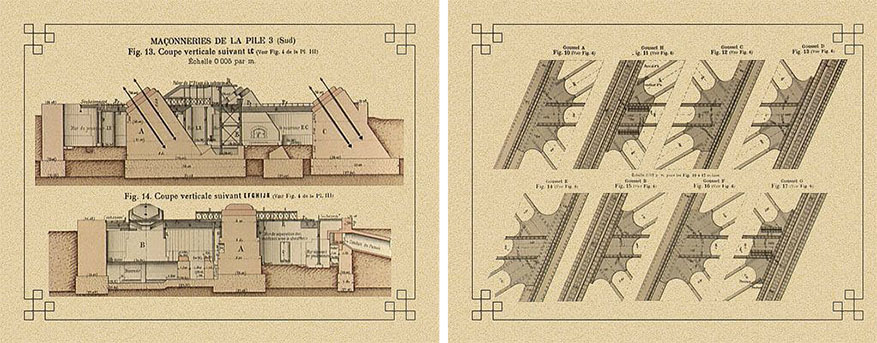
Each of 18,000 elements were pre-fabricated at a factory on the outskirts of the city, to a precision of .1 millimeters. The pieces were bolted together at the factory in segments, to ensure the 7 million holes lined up properly, then riveted for greater strength on site in four-man teams. The structure was subdivided into components with a maximum weight of 3 tons to reduce the risk of on-site accidents. The construction mechanisms were reused in the final design – visitors traveled up and down along tracks that had been used to haul parts during construction.
The 5300 sheets of drawings themselves are a work of art. From the toureiffel website:

Useless and Monstrous: Everyone’s A Critic
The tower is a universally beloved national landmark today but it went up to decidedly mixed reviews. The Exposition committee who had commissioned it, and the public who flocked to the fair grounds, passing through its enormous arch, were thrilled with the experience. But the residents of local neighborhoods feared that it might tip and fall on their homes, only ceasing in their demands for a stop-work when Eiffel himself insured the project. A group of Parisian artists and intellectuals banded together to protest the design of the tower:
“ We, the writers, painters, sculptors, architects and lovers of the beauty of Paris, do protest with all our vigor and all our indignation, in the name of French taste and endangered French art and history, against the useless and monstrous Eiffel Tower. “
Author Guy de Maupassant reputedly ate an embittered lunch regularly on the 1st level restaurant because it was the only place in Paris where he couldn’t see the tower.
In retrospect it almost sounds like a grumpy “kids these days” argument. What was seen as ghastly un-ornamented mechanics now seem lacy, delicate and serve as a symbol for the romance of Paris. If the artists who signed a petition to block Eiffel’s tower hated that, what would they have made of International Modernism … or of Brutalism?

250 Million Visitors: Eiffel Tower Through The Ages
Today the tower is s symbol that stands for a city and a culture but it was built for a specific event with a 20 year permit (Paris intended to disassemble it after its use). It was preserved not because the city had already fallen in love with its image but because it had become a valuable radio signal tower (it now broadcasts TV as well) and was to useful to take down. Even at the time of its construction, however, some recognized it as a herald of the new era of construction and modern possibility. As Eiffel defended his project:
“For my part I believe that the Tower will possess its own beauty. Are we to believe that because one is an engineer, one is not preoccupied by beauty in one’s constructions, or that one does not seek to create elegance as well as solidity and durability?”
To me, it is a perfect visual proof of the beauty of exposed structure, the elegance of (relatively) unadorned function; a case study in modernism.
Although its base use (a little science and a lot of tourism) hasn’t changed, the growing needs of serving the touring public have required some updates. A recent remodel of the tower has aimed to repair the elevators and to make the tower more energy efficient (adding solar hot water systems, LED ligthing and wind power generators) and more accessible to persons with disabilities, at least as far as the first level. The reconstruction has been designed by Moatti-Riviere Architects aims to give greater reasons for tourists to pause on the first level before racing to the top for the maximum view. Photo below via Dezeen’s coverage . Looks like it might be time for a return trip to Paris.

Related Insights
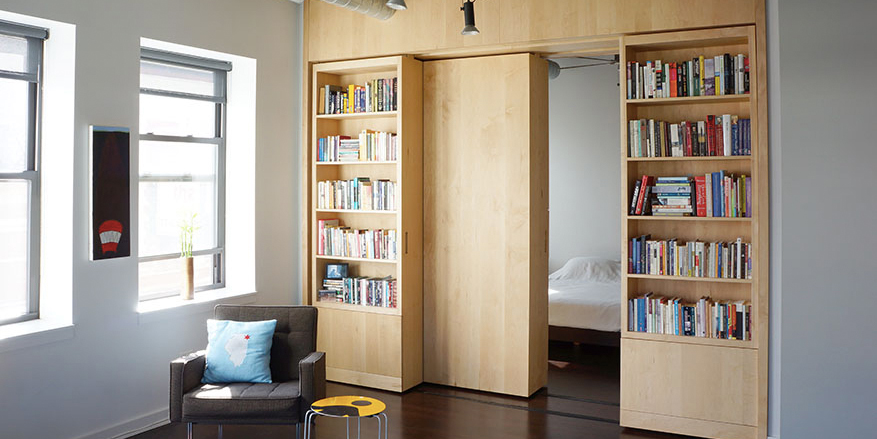
- How We Operate
Fit to A T: Why Moss Designs Custom Cabinetry

Building Materials Matter: or What Happens when the House the Third Little Pig Built … Falls Down

- Case Studies
The Sears (ahem, Willis) Tower and Chicago’s Skyline

Pioneering Modernist: Luis Barragan

Building Materials: Concrete under our Feet

- Uncategorized
Flint, MI Demonstrates America’s Lead Pipe Problem
- Les ateliers
Partager cet article
Maurice Koechlin, ce Suisse qui dessina la Tour Eiffel
Alors que le film «Eiffel» envahit nos salles, réhabilitons l’ingénieur suisse Maurice Koechlin. Il fut le premier à avoir l’idée de ce «pylône de 300 mètres», qui allait illuminer la Ville Lumière.
Né en 1856 à Buhl (Alsace), Maurice Koechlin a notamment étudié à Zurich, où il a pris la nationalité suisse. Mort à Veytaux (VD) en 1946, il est enterré à Vevey. A gauche, le dessin de son «pylône de 300 mètres», qui deviendra la tour Eiffel
Chaque fois qu’un automobiliste passe sur le viaduc de Chillon, il devrait avoir une pensée émue pour un autre édifice monumental bien présent dans notre imaginaire collectif: la tour Eiffel. Car cette autoroute aux vertus aériennes passe devant les fenêtres d’une maison anonyme, située dans un vallon de Veytaux, au-dessus de Montreux. Elle appartint et fut la dernière demeure de l’homme qui dessina la grande demoiselle parisienne. Il s’appelait Maurice Koechlin (1856-1946), était d’origine suisse et alsacienne et, si son nom n’a pas traversé les temps comme celui de Gustave Eiffel, il demeure le réel inventeur de la tour, celui qui la dessina le premier.
Le dessin, en 1884, de son «pylône de 300 mètres», qui deviendra la tour Eiffel.
Nullement amer, son arrière-petit-fils, Jean-David Koechlin, le rappelle avec une tendresse mêlée de respect. Encore aujourd’hui, il fond devant la tour Eiffel: «Je la trouve belle. Comme ma famille, j’en ai entendu parler pendant toute mon enfance. Mais pas du tout dans le sens d’une revendication, plutôt d’une admiration. Il n’y a jamais eu la moindre acrimonie entre Eiffel et mon ancêtre, qui fut son employé puis son successeur. Au contraire, leur relation était excellente, ils étaient amis. Je suis persuadé qu’Eiffel, qui vint beaucoup sur la Riviera vaudoise, a montré la région à Maurice, de 24 ans son cadet, et sans doute présenté la maison qu’il a achetée et où il a vécu à la fin de sa vie.»
L’histoire démarre quelques centaines de kilomètres plus au nord que les rives du Léman. Précisément à Mulhouse (Alsace), qui fut un haut lieu de l’industrie au XIXe siècle. Des textiles à la chimie, avec la finance bâloise pour appui, la ville rhénane connaît alors un essor phénoménal, jusqu’à être surnommée «la Manchester française». «On ne doutait de rien, on croyait au progrès», précise Jean-David Koechlin. Puis, catastrophe: la guerre de 1870 éclate et fait de Mulhouse une cité prussienne. Certaines des grandes familles protestantes qui faisaient la prospérité de la ville s’exilent. Les Koechlin choisissent la Suisse. Le père de Maurice envoie ses enfants au Polytechnicum de Zurich, à la pointe mondiale en matière d’ingénierie, alors que les plus jeunes vont chez Pestalozzi, à Neuchâtel.
Maurice, l’aîné, étudie à Zurich. Il reprend le passeport suisse que sa famille possédait avant de partir à Mulhouse et se forme auprès d’un professeur de grande qualité. Spécialiste de la «statique graphique», Karl Culmann lui apprend la méthode révolutionnaire dite des «poutres-caissons», qui permet de hisser des bâtiments à des hauteurs formidables. Le jeune élève est si passionné que, quand le grand constructeur parisien Eiffel, électrisé par ce savoir-faire suisse, demande au professeur zurichois de lui recommander un étudiant, celui-ci lui parle de Koechlin. Le jeune homme est engagé en novembre 1879 au sein de la société Eiffel. Il se frotte vite à un chantier audacieux, le viaduc ferroviaire de Garabit, en Auvergne, inauguré en 1884 et qui trône 122 mètres au-dessus de la rivière. Il y expérimente des piles de ponts qui ressemblent furieusement à la future tour. Puis il peaufine la charpente en fer de la statue de la Liberté, à New York, aux côtés de l’ingénieur Auguste Bartholdi, autre Alsacien.
Les constructeurs Maurice Koechlin, Stephen Sauvestre, Gustave Eiffel, Emile Nouguier et le fondé de pouvoir Adolphe Salles.
Il a 28 ans en 1884 quand il est nommé chef du bureau des études. L’Expo universelle de 1889 s’annonce, il s’agit de marquer les esprits. Ainsi, fort de ses récentes expériences, Koechlin dessine seul cette tour qui culmine à la hauteur symbolique de 1000 pieds, soit 300 mètres. On n’a jamais été aussi haut. Le plus grand monument est alors la cathédrale de Cologne et ses 150 mètres. Son projet, il le nomme simplement «pylône». «Il allait au sommet du possible en faisant confiance à l’intelligence humaine», note Jean-David Koechlin.
Le lendemain, il en parle à son collègue, le directeur technique Emile Nouguier, et tous deux s’en vont récolter la réaction du patron. Eiffel se montre moins euphorique. C’est un entrepreneur, pas un rêveur. S’il reconnaît l’audace du geste, il juge l’objet inesthétique et renvoie l’ingénieur à ses études, tout en l’encourageant. «Même si la marque des 1000 pieds l’impressionne, Eiffel souhaitait par exemple la présence d’une grande arche.» Koechlin retourne donc à sa table à dessin. Avec son collègue, ils font appel à l’architecte de l’entreprise, Stephen Sauvestre. Celui-ci a le génie d’«habiller» le monument, étage après étage. Outre l’arche inférieure, il ajoute par exemple un grand palais des congrès au premier, qui ne fut jamais construit. Et ne lésine pas sur les ornements, plaçant des statues sonnant de la trompette aux angles du deuxième étage.
Le descendant: Retraité à Annecy après avoir passé sa carrière professionnelle en Suisse romande, Jean-David Koechlin fait revivre la mémoire de son arrière-grand-père.
Cette fois, Eiffel est conquis. Il trouve la tour superbe et pressent les extensions scientifiques possibles, l’éclairage, la télégraphie optique. Imagine un phare qui illuminerait tout Paris. Toute sa vie, il profitera de la tour pour exercer différentes expériences, lâchera des objets des étages, calculera la pesanteur de Newton. Il dépose alors un brevet, avec Koechlin et Nouguier, «pour une disposition nouvelle permettant de construire des piles et des pylônes métalliques d’une hauteur pouvant dépasser 300 mètres». Peu après, il rachètera leurs droits à ses deux ingénieurs, en échange du versement à chacun de 1% du montant du coût de la construction de la tour, pour devenir le seul père du projet. Industriel puissant et reconnu, il est le seul capable de le mener à bien. Koechlin, lui, dirige la construction. Aucune des 18 038 pièces ne sort sans son accord. La tour est bâtie en deux ans, deux mois et cinq jours, inaugurée le 1er mars 1889. La Ville Lumière serait terne sans elle.
Dans le film récemment sorti, avec Romain Duris en Gustave Eiffel, Maurice Koechlin apparaît de façon anecdotique. Entre autres invraisemblances, la tour serait une œuvre d’Eiffel pour son amour de jeunesse: une invention.
Une histoire encore, que la famille Koechlin chérit: «A la débâcle, en juin 1940, mon arrière-grand-père a pris le dernier train pour la Suisse. Mais, alors que celui-ci avait mis beaucoup de temps à mettre au point les ascenseurs de la tour, Hitler les a comme par hasard trouvés en panne quand il a voulu monter. Le Führer a refusé de gravir les escaliers, il est resté en bas. En septembre 1944, quand Maurice Koechlin est retourné dans Paris libéré, les ascenseurs étaient réparés. Mon arrière-grand-père adorait raconter cette histoire à ses petits-enfants.» Ainsi, quelque part dans un cimetière de Vevey, à côté de celle de son épouse Emma Rossier, une Veveysanne qu’il connut pendant ses études et qui lui donna six enfants, une tombe perpétue la mémoire de ce grand modeste, au rêve si élevé.
- History Classics
- Your Profile
- Find History on Facebook (Opens in a new window)
- Find History on Twitter (Opens in a new window)
- Find History on YouTube (Opens in a new window)
- Find History on Instagram (Opens in a new window)
- Find History on TikTok (Opens in a new window)
- This Day In History
- History Podcasts
- History Vault
Eiffel Tower
By: History.com Editors
Updated: June 7, 2019 | Original: June 13, 2011

When Gustave Eiffel’s company built Paris’ most recognizable monument for the 1889 World’s Fair, many regarded the massive iron structure with skepticism. Today, the Eiffel Tower, which continues to serve an important role in television and radio broadcasts, is considered an architectural wonder and attracts more visitors than any other paid tourist attraction in the world.
Designing and Building the Eiffel Tower
In 1889, Paris hosted an Exposition Universelle (World’s Fair) to mark the 100-year anniversary of the French Revolution . More than 100 artists submitted competing plans for a monument to be built on the Champ-de-Mars, located in central Paris, and serve as the exposition’s entrance. The commission was granted to Eiffel et Compagnie, a consulting and construction firm owned by the acclaimed bridge builder, architect and metals expert Alexandre-Gustave Eiffel. While Eiffel himself often receives full credit for the monument that bears his name, it was one of his employees—a structural engineer named Maurice Koechlin—who came up with and fine-tuned the concept. Several years earlier, the pair had collaborated on the Statue of Liberty’s metal armature.
Did you know? The base pillars of the Eiffel Tower are oriented with the four points of the compass.
Eiffel reportedly rejected Koechlin’s original plan for the tower, instructing him to add more ornate flourishes. The final design called for more than 18,000 pieces of puddle iron, a type of wrought iron used in construction, and 2.5 million rivets. Several hundred workers spent two years assembling the framework of the iconic lattice tower, which at its inauguration in March 1889 stood nearly 1,000 feet high and was the tallest structure in the world—a distinction it held until the completion of New York City’s Chrysler Building in 1930. (In 1957, an antenna was added that increased the structure’s height by 65 feet, making it taller than the Chrysler Building but not the Empire State Building, which had surpassed its neighbor in 1931.) Initially, only the Eiffel Tower’s second-floor platform was open to the public; later, all three levels, two of which now feature restaurants, would be reachable by stairway or one of eight elevators.
Millions of visitors during and after the World’s Fair marveled at Paris’ newly erected architectural wonder. Not all of the city’s inhabitants were as enthusiastic, however: Many Parisians either feared it was structurally unsound or considered it an eyesore. The novelist Guy de Maupassant, for example, allegedly hated the tower so much that he often ate lunch in the restaurant at its base, the only vantage point from which he could completely avoid glimpsing its looming silhouette.
The Eiffel Tower Becomes a Permanent Feature of the Paris Skyline
Originally intended as a temporary exhibit, the Eiffel Tower was almost torn down and scrapped in 1909. City officials opted to save it after recognizing its value as a radiotelegraph station. Several years later, during World War I , the Eiffel Tower intercepted enemy radio communications, relayed zeppelin alerts and was used to dispatch emergency troop reinforcements. It escaped destruction a second time during World War II : Hitler initially ordered the demolition of the city’s most cherished symbol, but the command was never carried out. Also during the German occupation of Paris, French resistance fighters famously cut the Eiffel Tower’s elevator cables so that the Nazis had to climb the stairs.
Over the years, the Eiffel Tower has been the site of numerous high-profile stunts, ceremonial events and even scientific experiments. In 1911, for instance, the German physicist Theodor Wulf used an electrometer to detect higher levels of radiation at its top than at its base, observing the effects of what are now called cosmic rays. The Eiffel Tower has also inspired more than 30 replicas and similar structures in various cities around the world.
Now one of the most recognizable structures on the planet, the Eiffel Tower underwent a major facelift in 1986 and is repainted every seven years. It welcomes more visitors than any other paid monument in the world—an estimated 7 million people per year. Some 500 employees are responsible for its daily operations, working in its restaurants, manning its elevators, ensuring its security and directing the eager crowds flocking the tower’s platforms to enjoy panoramic views of the City of Lights.

Sign up for Inside History
Get HISTORY’s most fascinating stories delivered to your inbox three times a week.
By submitting your information, you agree to receive emails from HISTORY and A+E Networks. You can opt out at any time. You must be 16 years or older and a resident of the United States.
More details : Privacy Notice | Terms of Use | Contact Us

The birth of the Eiffel tower
A realized utopia, eiffel tower.
You are at the top of the Eiffel Tower, overlooking Paris at a height of almost 300 m / 1000 feet.
At the opening of the Tower in 1889, this very place was different from what you are seeing.
Le Campanile et le Phare de la tour Eiffel - Les merveilles de l'Exposition 1889 by © Collection tour Eiffel Eiffel Tower
It was used, in particular, as a laboratory to carry out scientific experiments and measurements. Many instruments were installed here such as barometers, anemometers, lightning conductors.
In fact, Gustave Eiffel arranged an office for himself at the very top of the Tower for astronomical and physiological observations. He even installed a weather station.
It was these scientific experiments carried at the Tower which saved it from being destroyed by popular demand. Did you know the Tower should have been pulled down just 20 years after it was erected for the 1889 Exposition Universelle!
Affiche - Chemin de fer Paris-Lyon-Méditerranée - Exposition Universelle 1889 - Paris by © Collection tour Eiffel Eiffel Tower
For the 1889 Universal Exhibition, marking the centenary of the French Revolution, a great competition was announced in the country's Official Gazette.
Universal exhibitions were a technological and industrial showcase for nations, testifying to the achievements made during the industrial revolution.
Le Champ de Mars et l'Ecole Militaire depuis les hauteurs du Trocadéro avant la construction de la tour Eiffel by © Collection tour Eiffel Eiffel Tower
The 1889 competition consisted of "studying the possibility of erecting on the Champ-de-Mars a 300-metre tower with a 125m2 square base".
The Champ-de-Mars and the Military school as seen from the Trocadéro before the construction of the Eiffel Tower.
Selected from among 107 projects, it was that of Gustave Eiffel, an entrepreneur, Maurice Koechlin and Emile Nouguier, both engineers, and Stephen Sauvestre, an architect, that was accepted.
Gustave Eiffel en pied dans l'escalier de la tour Eiffel by © Collection tour Eiffel Eiffel Tower
A brilliant engineer, Gustave Eiffel founded a company specialising in metal structural work.
In this sense the Eiffel Tower was the very height of his career. He devoted the last thirty years of his life to experimental research.
This enthusiast and true genius was able to transcend his own limits to leave us monuments such as the dome on the Nice Observatory, the metal structure of the Statue of Liberty and the Bordeaux railway bridge.
Bureau des Etudes de Gustave Eiffel - La Tour Soleil de Bourdais, projet concurrent de la tour Eiffel (calque à la plume) by © Collection tour Eiffel Eiffel Tower
The competition held at the time of the 1889 Exposition Universelle received several other entries for 300-metre towers.
A serious component was the project of Jules Bourdais, he was the architect of Palais du Trocadéro.
He imagined a tower of 300 m based only of stone.
Dessin projet de MM Eiffel, Nouguier et Koechlin by © Collection tour Eiffel Eiffel Tower
In June 1884, Emile Nouguier and Maurice Koechlin, the two chief engineers in Eiffel's company, came up with the idea of building a very tall tower. It was to be designed like a large pylon.
It would have four columns of latticework girders, separated at the base and coming together at the top, and joined to each other by more metal girders at regular intervals.
Pylône de 300m de hauteur pour la ville de Paris - 1889 - Avant Projet de MM Nouguier et Koechlin by © Collection tour Eiffel Eiffel Tower
The company had by this time perfectly mastered the principle of building bridge supports. The tower project was a bold extension of this principle up to a height of 300 metres - equivalent to the symbolic figure of 1,000 feet.
Reproductions des planches originales de Gustave Eiffel by © Collection tour Eiffel Eiffel Tower
On 18 September 1884, Eiffel registered a patent “for a new configuration allowing the construction of metal supports and pylons capable of exceeding a height of 300 metres”.
Sauvestre proposed stonework pedestals to dress the legs, monumental arches to link the four columns and the first level, large glass-walled halls on each level, a bulb-shaped design for the top and various other ornamental features to decorate the whole of the structure.
The first floor - Copy of Gustave Eiffel's original plates
The second floor - Copy of Gustave Eiffel's original plates
The top - Copy of Gustave Eiffel's original plates
Antennas - Copy of Gustave Eiffel's original plates
The first digging work started on 26 January 1887 and marked the beginning of the Tower's construction.
Conception—Société d'Exploitation de la Tour Eiffel
The Eiffel Tower in 1900
The eiffel tower's inauguration and first visitors, the construction of the eiffel tower.

The History of the (tumultuous) construction of the Eiffel Tower
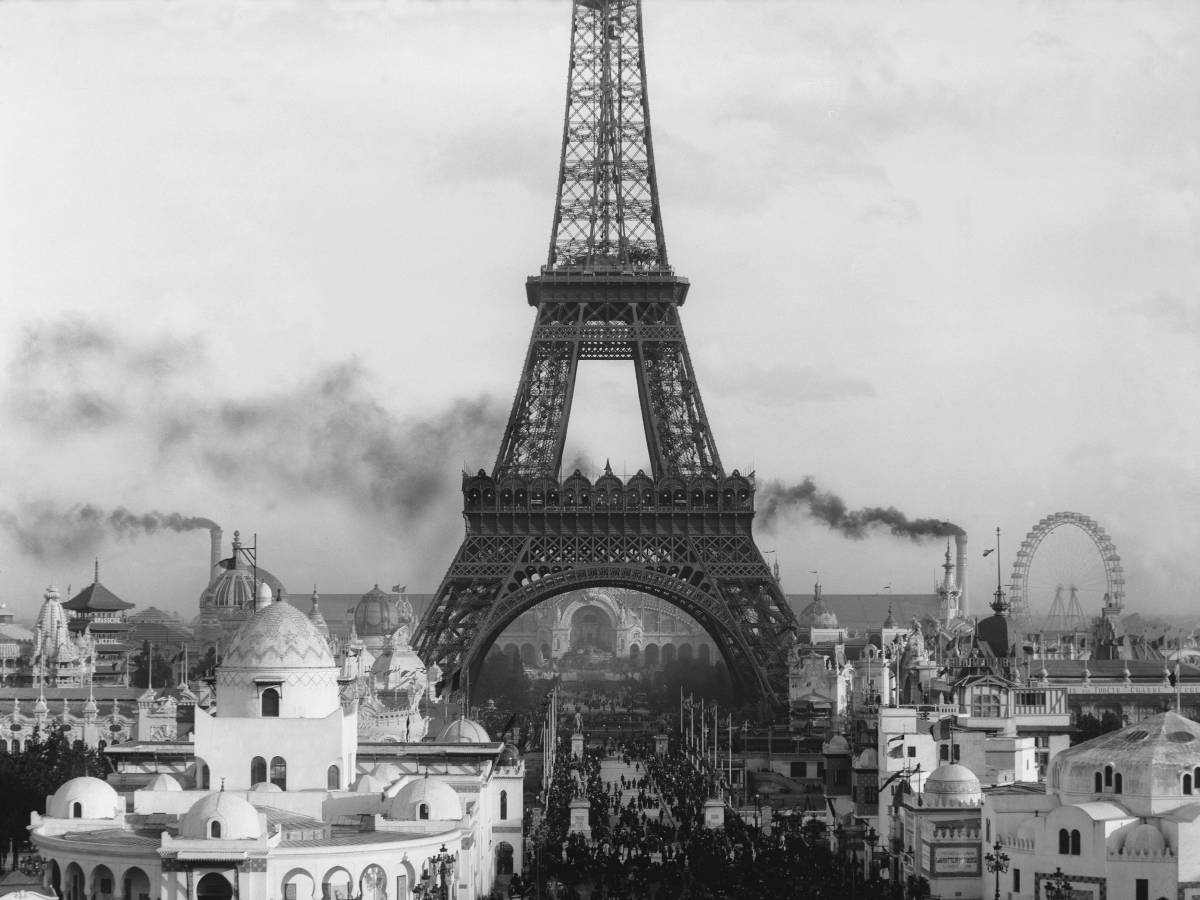
March 31, 1889, the Eiffel Tower was inaugurated after two years and two months of construction. What was the tallest building in the world had to be the leading monument of the 1889 Paris World’s Fair, which theme was the French Revolution.
A tower that should celebrate the progress of science and technology in France since 1789, but which construction set off several debates, especially from French artists and intellectuals who published articles and pamphlets against this “Tower of Babel”.
First temporary, then threatened with destruction, the Eiffel Tower was however an immediate success when it opened for the 1889 World’s Fair. A monument that has been able to impose itself despite the controversy, nowadays the most famous monument in the world.
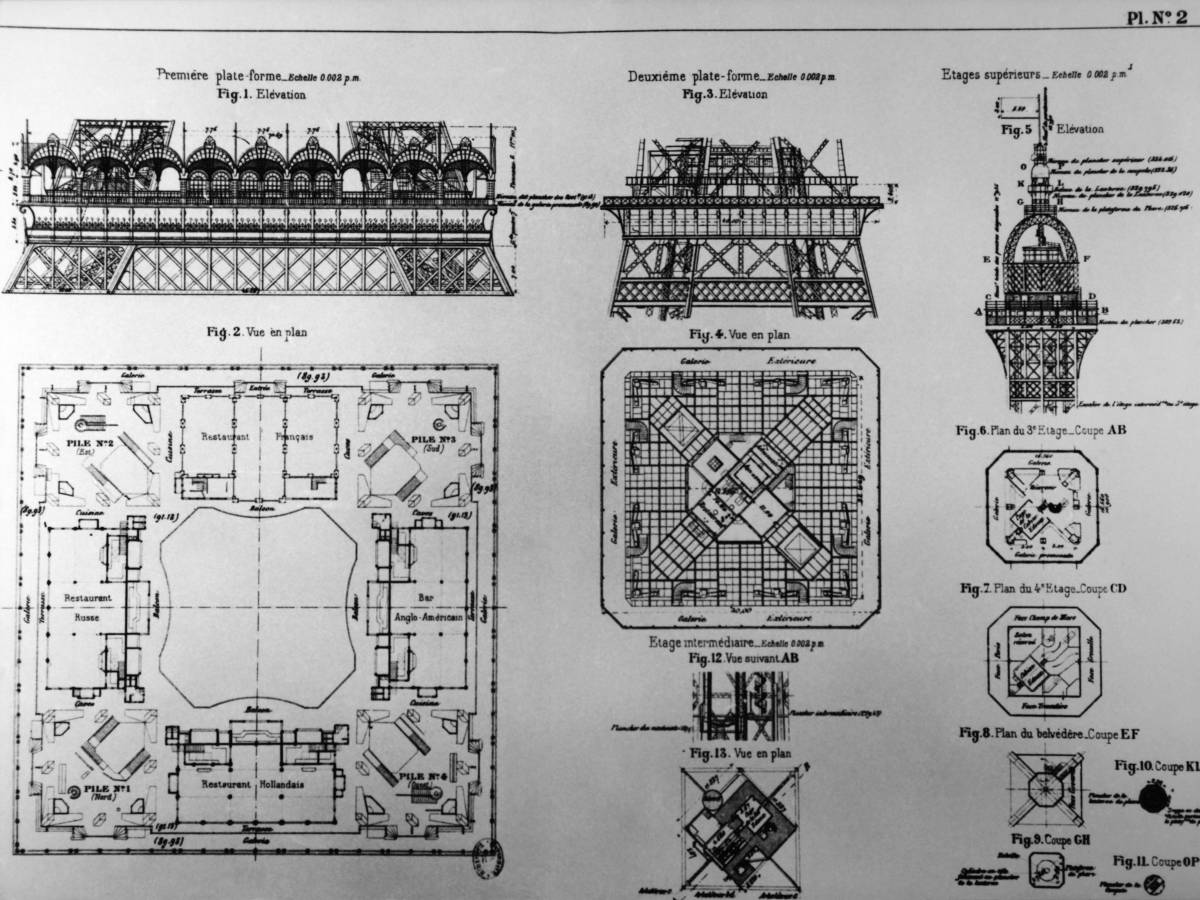
The design of the Eiffel Tower was originated by Maurice Koechlin and Emile Nouguier, two engineers working for the Eiffel Institutions Company. Initially skeptical, Gustave Eiffel bought the patent rights of the two engineers and presented his plans in 1885. A monument as a symbol of modern engineering and industrial progress throughout the 19th century.
In 1886, Gustave Eiffel finish 3rd in the competition, and signed an agreement with the government allowing him to build his tower.
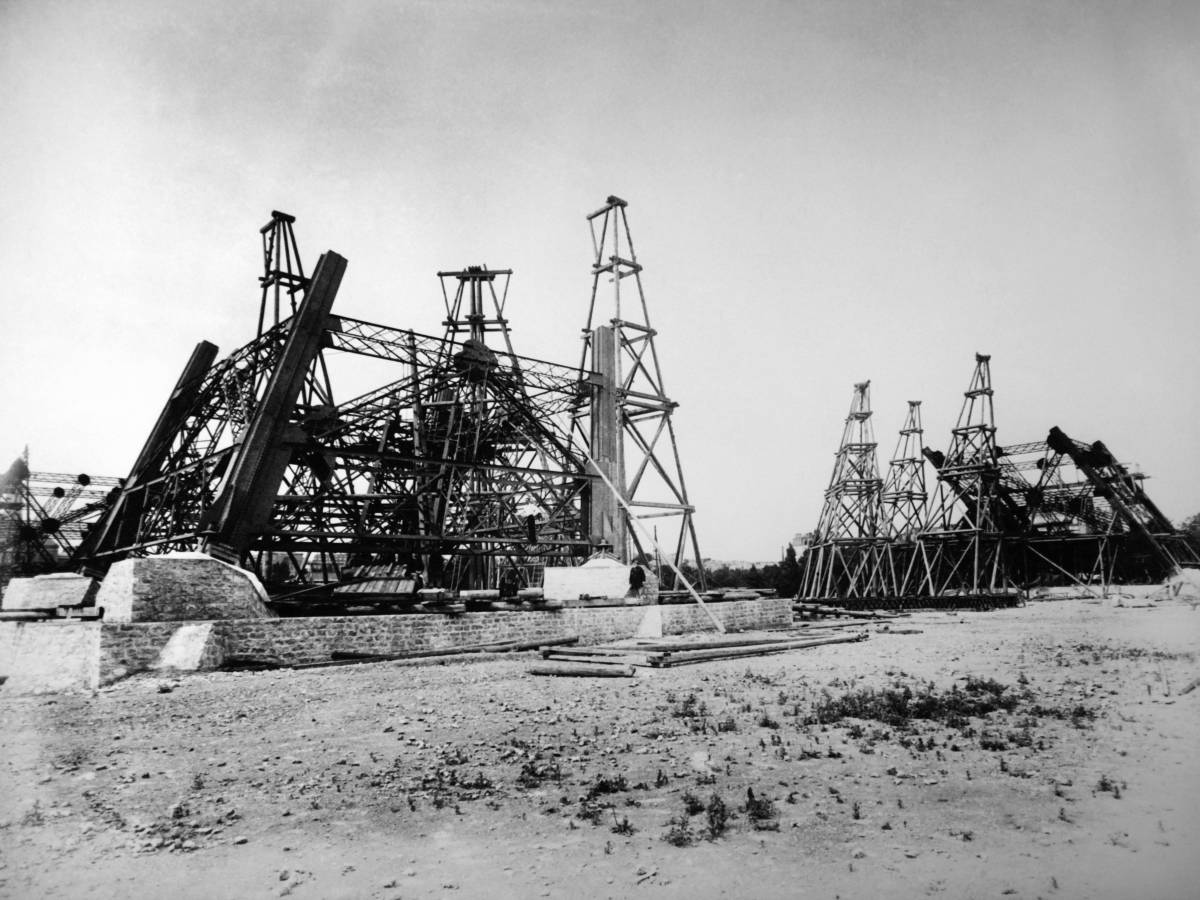
The agreement signed July 8, 1887 stipulated that from 1 January 1890, Gustave Eiffel could freely enjoy the commercial exploitation of its tower for a period of twenty years, after which the City of Paris would be the owner.
Works on the foundations began January 28, 1887.
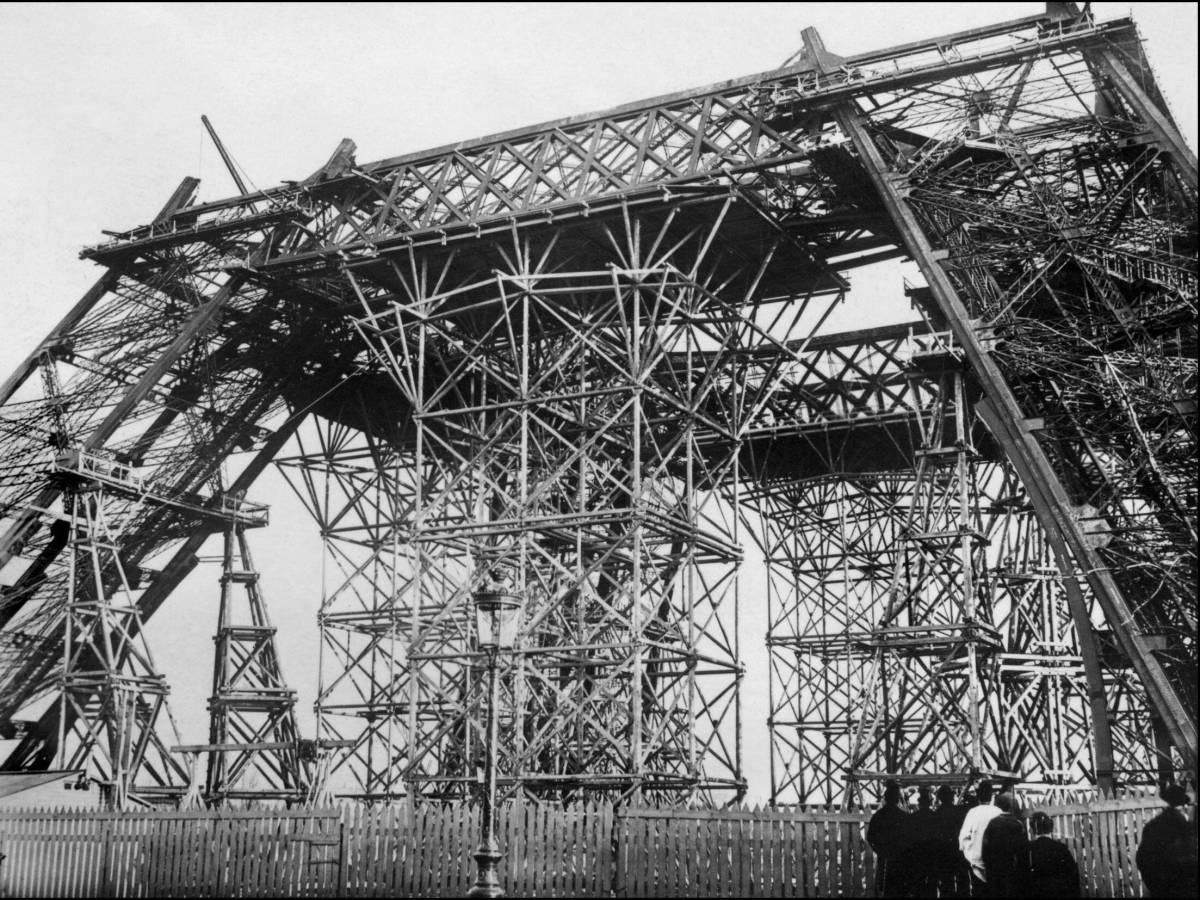
More than 300 workers were responsible for assembling the structure.
The critics
Soon, many people were questioning the aesthetic and utility of this tower, newspapers criticizing the soundness of the project. Saying such a tall monument was not possible to build, even inhabitants of the Champ de Mars gathered to bring an action against the state.
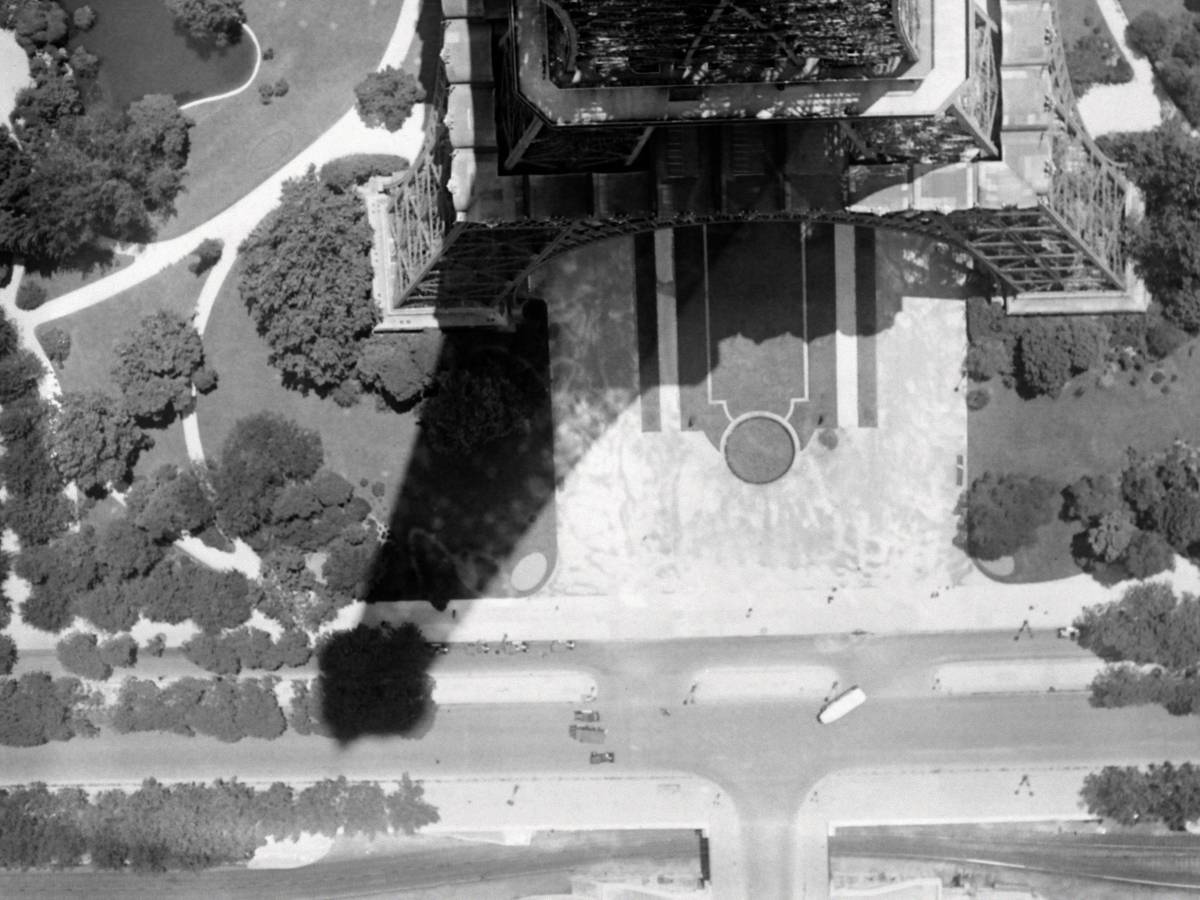
But the highlight of this critics was an open letter against the Eiffel Tower, published in the newspaper Le Temps on February 14, 1887, and signed by artistes like Joris-Karl Huysmans, Guy de Maupassant, Alexandre Dumas Fils or Charles Garnier
Read this letter (in French)

Inauguration
March 1898, the the structure was almost completed, and March 31, Gustave Eiffel inaugurated the monument by leading a group of government official and members of the press to the top of the tower. At the opening of the World’s Fair, the lifts were not working yet, what did not prevent the every-day 30 000 visitors to climb the 1,710 steps.
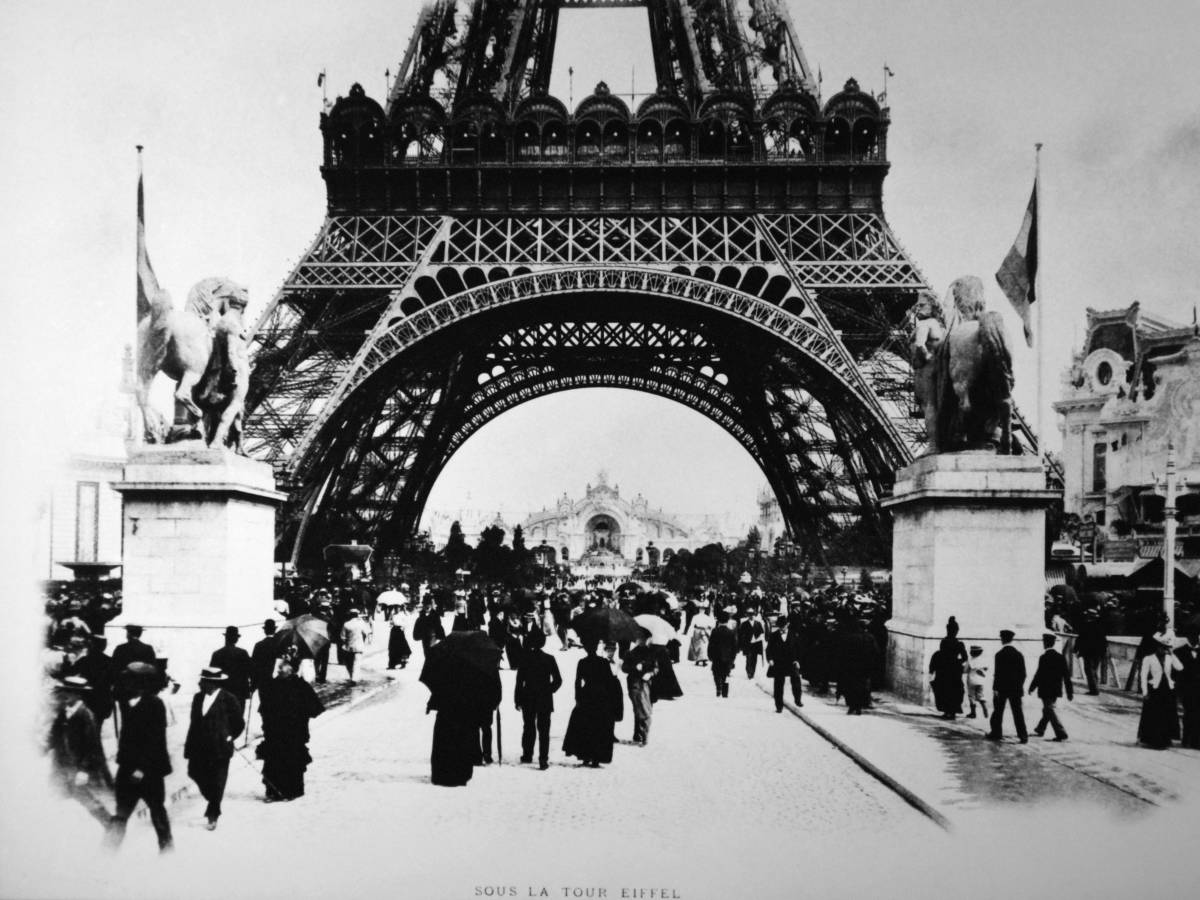
While the City of Paris became the owner of the Tower after the 20-year concession, the tower had to be destroyed. Tanks to its public success, but also to and its unique structure and height allowing scientific experiments, the destruction will be delayed.
Quickly became a symbol of Paris and France, its original critics will recognize the innovative character of the tower, and even today, the Eiffel Tower is the most visited monument in the world.

Guided Tours
Useful informations.
(Français) Rejoignez-nous sur Facebook
Related post
Structured data
Items portrayed in this file.
- Architectural drawings of the Eiffel Tower
- PD-old-100-expired
- Images with annotations
Navigation menu
- Skip to main content
- Skip to primary sidebar
- Skip to footer

Why Was the Eiffel Tower Built?
Brandon Shaw Last Updated: February 2, 2023
The Eiffel Tower is easily one of the world’s most recognizable buildings, but why was it built? Was it built for the sole purpose of being beautiful? The answer is “sort of” and things article will explain it all.
Pro Tip: Planning your trip to the Eiffel Tower in Paris? Bookmark this post in your browser so you can easily find it when you’re in the city. Check out our guide to Paris and the Eiffel Tower for more planning resources, our top Paris tours for a memorable trip, and find out if a tour of the Eiffel Tower is worth it .
Why Did France Decide to Build the Eiffel Tower?
City planning comes with many responsibilities. Some of which are needs of the city such as plumbing, sanitation, and health requirements. Then there are certain marketing aspects that are very important to a cities success. You’ll need beautiful monuments that draw visitors and allow businesses to thrive.
So why did they build the Eiffel Tower? It most certainly was not for sanitary reasons but more so to draw crowds. That said, the mayor of Paris did not wake up on a Thursday and decided to commission an expensive monstrosity. It was all based around an event of global proportions!
Eiffel Tower Facts
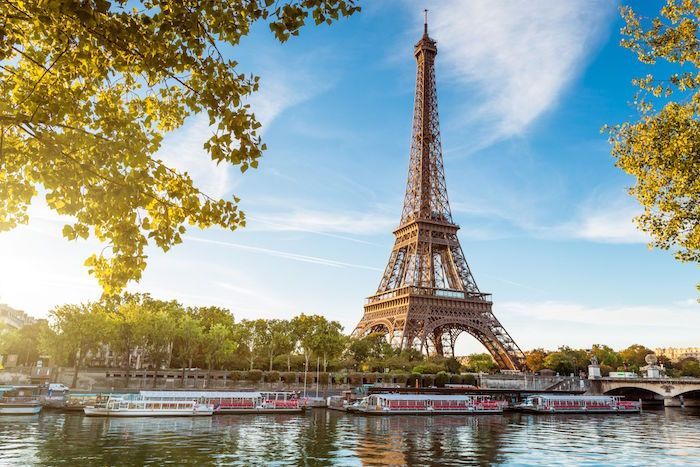
Before we jump into the whole story, let’s just get familiar with the incredible iron tower we all know and love. Before reading on, let’s go over some quick Eiffel Tower facts:
- When was the Eiffel Tower built? Between 1887-1889
- How tall is the Eiffel Tower? 1,063 feet
- Who built the Eiffel tower? Maurice Koechlin and Émile Nouguier under the direction of Gustave Eiffel
- What is the Eiffel Tower made of? Wrought iron
- How many levels are there? There are three levels . There’s the first floor, the popular second floor, and the exclusive summit. All are accessible by elevator, but you can also walk to the first and second levels.
Construction of the Eiffel Tower
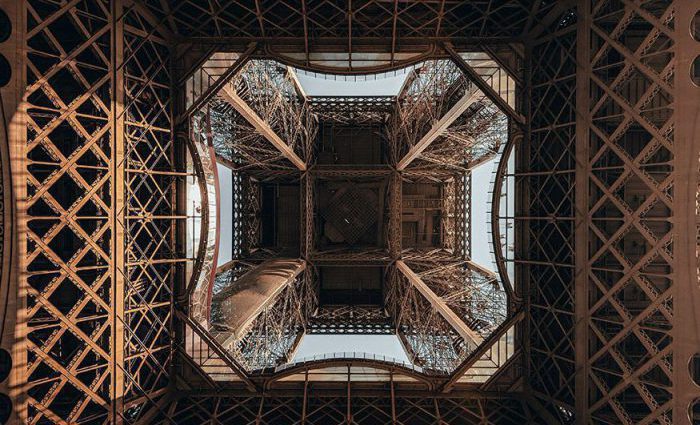
Why was the Eiffel Tower built? Let’s go back: the 1889 Exposition Universelle in Paris was being organized to celebrate the 100 th anniversary of the fall of the Bastille and the beginning of the French Revolution. Two years earlier, one plan had been selected from 107 proposals for an adequate centerpiece for this grand event.
Although the Tower bears the name of famed Parisian civil engineer Gustave Eiffel, its plans were initially drafted by two leading engineers at his firm, Maurice Koechlin and Émile Nouguier. With the help of the company’s chief architect Stephen Sauvestre, and eventually the support of Eiffel himself, the Tower was ready to be built.
Construction began on February 28, 1887. After just over 2 years, on March 31, 1889, Gustave Eiffel himself showed a group of government officials and journalists up the newly-completed tower. The elevators were not yet in operation, but a few of the group made it all the way to the top using the 1,710 stairs!
The French tricolor flag was raised and a 25-gun salute was fired. A few months later, the World’s Fair officially began and members of the public thronged to the tower – almost 2 million people climbed it during the Fair alone.
Not ready to book a tour? Find out if a tour of the Eiffel Tower is worth it .
The Public’s Response
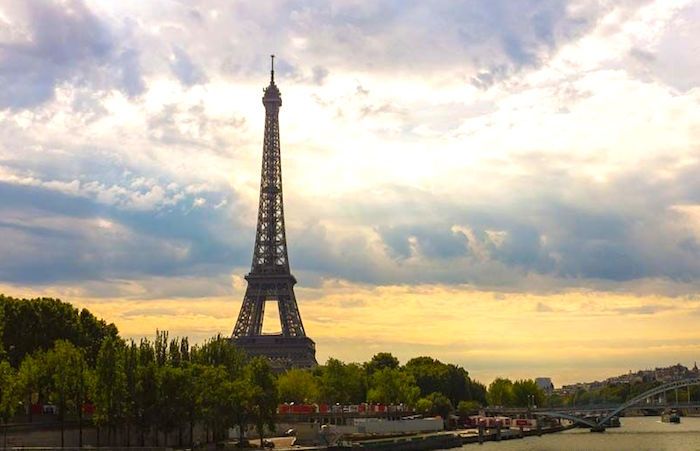
A number of prominent Parisians protested the building, saying it did not fit in with the rest of the city. One famous opponent, the writer Guy de Maupassant, was vocal about hating the tower long after its construction but ate at its restaurant frequently. When confronted with this apparent contradiction, he claimed to frequent the Eiffel Tower’s restaurant because it was the only place in the city where you couldn’t see the tower!
The Eiffel Tower is immense ly p opular today despite the early protests. It also now see s more visitors than any other paid attraction in the entire world. An estimated 6-7 million people a year get tickets to go up and see Paris from on high.
At 986 feet tall upon construction, the Eiffel Tower surpassed the Washington Monument in Washington, D.C. as the tallest building in the world. It held the title for about forty years (it was bested by New York’s Chrysler Building in 1930) and is still the tallest building in Paris. I t is made of wrought iron which means it grows and shrinks with temperatures – in summer, it’s about six inches higher than in the winter.
Eiffel Tower Renovations
In 1889, the tower was a reddish-brown color which is not nearly as bad as when it was painted yellow! Yes, ten years later the tower was painted yellow which would be difficult to picture now.
After a few more changes in appearance (including a spell from 1925 and 1936 when it featured a brilliantly-lit ad on its side for the French automaker Citroen), a final color was finally selected in 1968: “Eiffel Tower Brown”. And to look its best, the tower is actually painted in three different graduated shades.
The color has remained constant for a while, but that doesn’t mean the Eiffel Tower isn’t getting regular face-lifts – it’s completely repainted with 60 tons of paint every seven years. And every night since 1985, the tower has featured a 5-minute light show at night, every hour, on the hour, with magical sparkling lights and a powerful beacon shining from the top of the tower.
Where is the Eiffel Tower?
Located on the Champ de Mars in Paris, the tower can be accessed from the Metropolitan stop Bir-Hakeim. Tickets can be bought online and are around 25 euros per adult to get up to the very top (the price is lower if you only go to the “second level.” Or, you can check out our guided Eiffel Tower Tour , which also includes a Seine riverboat cruise.
Not ready to book a tour? Find out what the best tours of the Eiffel Tower are for you.
Eiffel Tower Restaurants
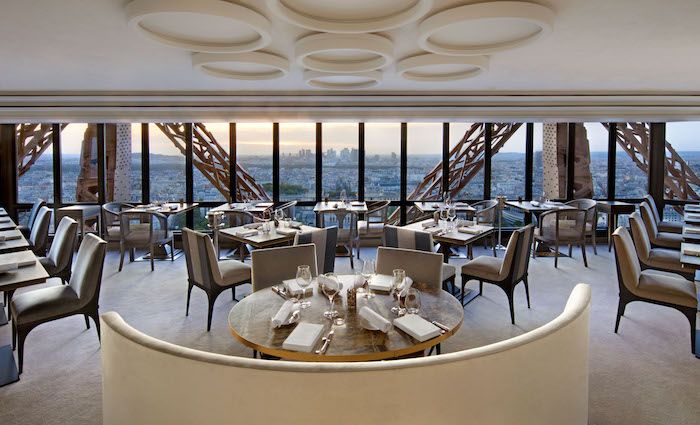
The Eiffel Tower offers the unique experience of dining in one of its two restaurants: one, Le 58 Tour Eiffel, is on the first level. On the second level, there’s the even more exclusive and elegant Le Jules Verne . And on the top of the tower, there is – what else? – a champagne bar. For more on the Eiffel Tower restaurants and how to reserve read our article on everything you need to know to visit the Eiffel Tower .
Like a lot of landmark buildings, though, the beauty of the Eiffel Tower is not just in the experience of visiting it or climbing it – it’s that you can enjoy it from countless vantage points around the city. It provides an iconic and romantic backdrop for all your Parisian adventures.
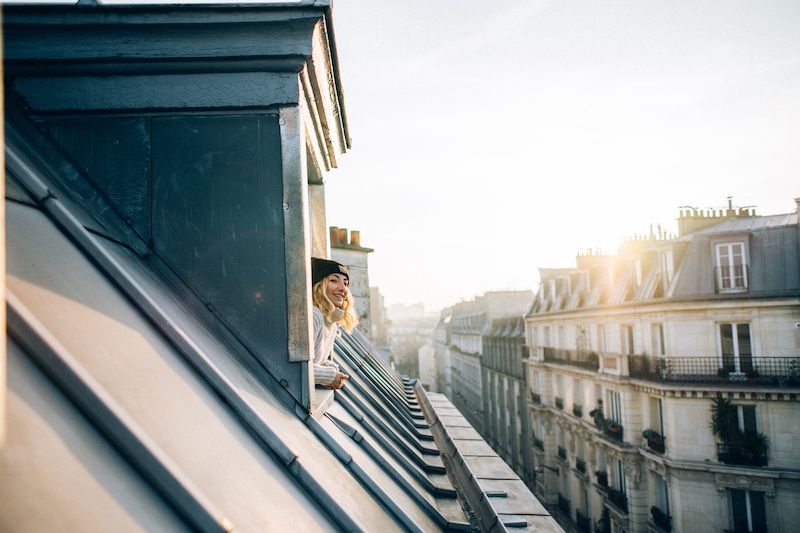
Where To Stay in Paris
With a city as magnificent as Paris, it can be hard to find the perfect hotel at the perfect price. Explore the best hotels and places to stay in these incredible neighborhoods in Paris.
Our Best Guided Tours of Paris
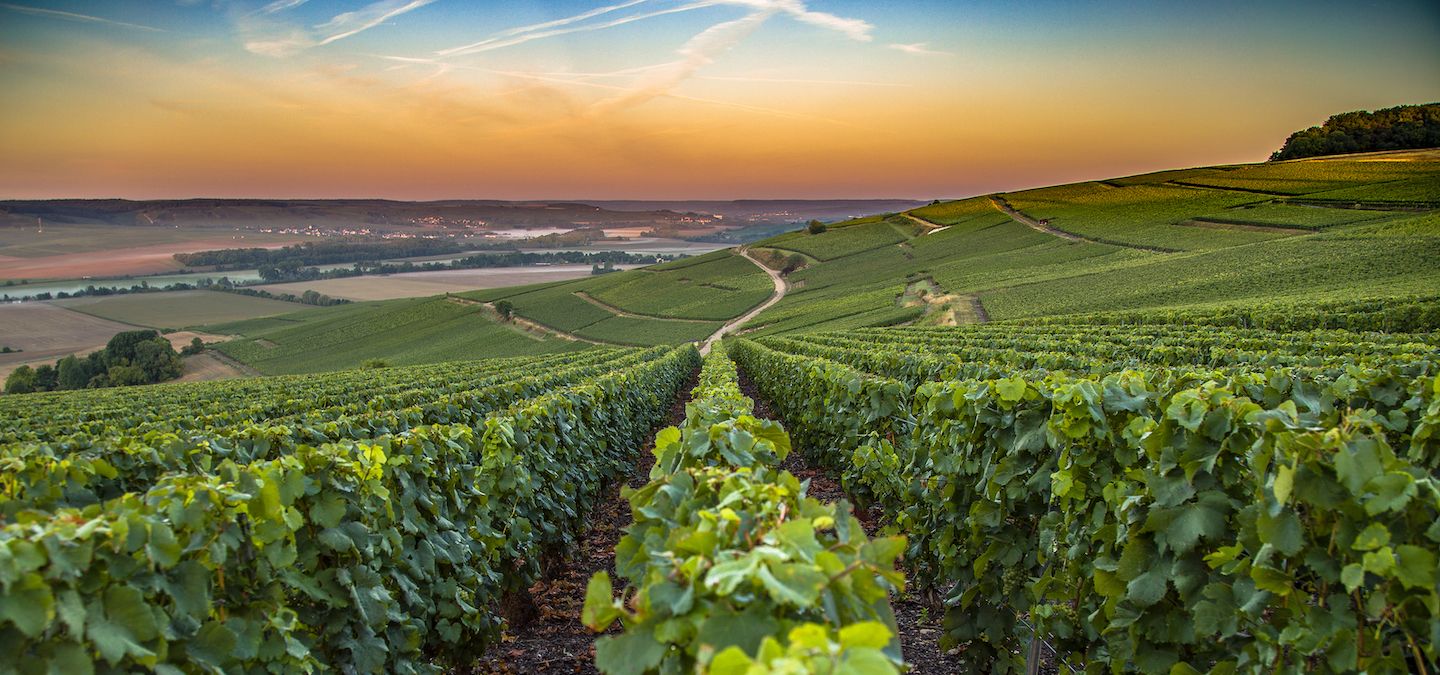
Likely to Sell out
Champagne Day Trip From Paris with Lunch
Sometimes the most amazing moments happen by chance. Other times, they are orchestrated by professionals. Explore iconic Champagne houses like Moët & Chandon and Veuve Cliquot hassle-free. We’ve partnered with top wineries, expert guides, and local eateries to offer personalized tours, complete with round-trip transportation from Paris.
Top Selling
Ultimate Taste of Paris Food Tour in Le Marais
Embark on a culinary journey in Le Marais—one of the hippest neighborhoods in Paris. Most food tours in Paris offer cheese and wine, but we include a full, sit-down meal! Enjoy a feast of French cheeses, oysters, street food, boeuf bourguignon, crème brûlée, and more. This 3-hour food tour combines the best of Paris’ culinary heritage and you won’t find a better deal out there!
I Want More Paris!
- Not sure what to do in Paris? Check out our step-by-step guide about how to do Paris in a Day . If you’d rather let us guide you, check out our Paris tours .
- Parlez-Vous Francais ? Learn some of the most important French phrases before your trip to Paris.
- Follow our European adventures on Facebook , Instagram and YouTube . Then, comment and tell us what you want us to cover next.
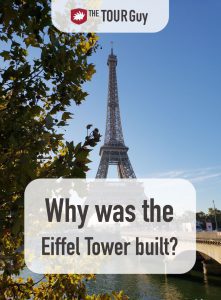
About Brandon Shaw
Brandon is a co-founder and owner of The Tour Guy and its subsidiary The Roman Guy. He left the States to travel the world at 18 and never looked back! As an official Tour Guide of Rome and Certified Sommelier, he loves to travel the world and share these experiences with his readers.
Reader Interactions
Leave a comment cancel reply.
Your email address will not be published. Required fields are marked *
- Travel Blog
- In The Press
POLICY & TERMS
- Cancellation Policy
- Terms & Conditions
- Privacy Policy

History and culture

Thanks to the phonograph, Gustave Eiffel's voice travels through the ag...
Incredible! Listen to Gustave Eiffel's voice and discover the history of how it was recorded.

When the Eiffel Tower was a subject of controversy

The little-known works of Gustave Eiffel

Before and after: travel back in time through photos

The foundations and basements of the Eiffel Tower

Maurice Koechlin, the engineer without whom the Tower would not exist

From 300 to 330 meters: the story of the Tower’s height

Everything you need to know about the Eiffel Tower at night

A mobile tour guide to discover the Eiffel Tower !

What to see around the Eiffel Tower ?

133 years and 1,083 feet!

The Iron Lady: nicknaming the Eiffel Tower

The Eiffel Tower, a movie diva

Who sold the Eiffel Tower?

Why does the Eiffel Tower change size?

A century of the Eiffel Tower seen from the sky!
- Prices & Times
- Haut de page

IMAGES
VIDEO
COMMENTS
French-Swiss engineer Maurice Koechlin was one of Gustave Eiffel's most loyal partners. Born on March 8, 1856 in the Haut-Rhin, he was hired by the Eiffel company in 1879 after graduating from the Polytechnicum in Zurich, where he had studied under Karl Culmann and discovered graphic statics (an entirely geometrical method of solving static mechanics problems), which would later be of great ...
Eiffel et Koechlin sont restés amis jusqu'à la mort de Gustave Eiffel en 1923. Maurice Koechlin, lui, s'éteint le 14 janvier 1946 à Veytaux en Suisse. Au 1er étage de la tour Eiffel, pour rendre hommage à ses deux inventeurs, la coursive extérieure entre le pilier sud et le pilier ouest a été renommée « Rue Maurice Koechlin et ...
In 1884 Koechlin became the head of Eiffel's engineering department at the age of 28. The Universal Exhibition in 1889 offered a chance to make a lasting impression: working alone and bolstered by his recent experience, Koechlin drew a sketch for a tower that reached the symbolic height of 1,000 feet (300 metres) - taller than any existing ...
The Eiffel Tower (/ ˈ aɪ f əl / EYE-fəl; French: Tour Eiffel [tuʁ ɛfɛl] ⓘ) is a wrought-iron lattice tower on the Champ de Mars in Paris, France.It is named after the engineer Gustave Eiffel, whose company designed and built the tower from 1887 to 1889.. Locally nicknamed "La dame de fer" (French for "Iron Lady"), it was constructed as the centerpiece of the 1889 World's Fair, and to ...
Emile Nouguier and Maurice Koechlin: creative engineers. In May 1884, therefore, the two main engineers of the Eiffel company met to look for an idea that would make the upcoming Exhibition "more attractive." Émile Nouguier had been in charge of the company's construction sites for ten years. He was a veteran of the steel construction sector.
C'est à Maurice Koechlin que l'on doit l'idée de la construction d'une tour en métal à Paris, à l'occasion de l'Exposition internationale, idée qu'il suggère à Gustave Eiffel dès le mois de juin 1884. Il est secondé par l'ingénieur Émile Nouguier dans la conception de ce projet. Dans un premier temps Eiffel ne s'intéresse pas au ...
Maurice and Emma were lifelong members of the Plymouth Brethren . In 1887 he started work on his plans for the "Tour de 300 mètres" in Paris, along with his younger brother Henri Koechlin and civil engineer Émile Nouguier. Maurice Koechlin became the Managing Director of Eiffel's company when Eiffel retired from the engineering profession in ...
It is said that during that time Koechlin made the only personal statement regarding the 300-meter-tower, in cooperation with Eiffel, in which he states: „Le père de la Tour c'est Eiffel - mais l'idée et les calculs, c'est moi." („The Towers father is Eiffel, but the idea and calculation were made by me").
Eiffel agreed to build upon their vision. He worked with architect Stephen Sauvetre, civil engineer Émile Nouguier, and structural engineer Maurice Koechlin to envision a three-leveled, 1,063-foot (or 300 meters) tower made of wrought iron. In addition to showcasing his engineering skills, Eiffel intended to commemorate the French Revolution ...
Biography. Maurice Koechlin was the head of the design office of the Eiffel companies. Mr. Maurice Kœchlin was born in Buhl (Alsace), in 1856. After his classical studies at the College of Mulhouse, he moved to the Strasbourg Gymnasium, then he entered the Ecole Polytechnique of Zurich, a famous scientific institution that rivals Switzerland with our great school and from which he left the first.
The design of the Eiffel Tower was originated by Maurice Koechlin and Emile Nouguier, two senior engineers who worked for the Compagnie des Etablissements Eiffel after discussion about a suitable centrepiece for the proposed 1889 Exposition Universelle, a World's Fair which would celebrate the centennial of the French Revolution.
Three engineers from Eiffel's firm, Maurice Koechlin, Emile Nouguier, and Stephen Sauvestre came up with the design. Jean Compagnon and Adolphe Salles managed its construction, and Eiffel asked ...
Eiffel Tower (Tour de 300 mètres) Gustave Eiffel, designer; Stephen Sauvestre, architect; Maurice Koechlin and Emile Nouguier, engineers The Eiffel Tower is the only surviving structure from the 1889 exposition. This view was taken from the Palais du Trocadéro. 6 of 24.
Little known fact: the architect of the Eiffel Tower was not engineering entrepreneur, Gustave Eiffel. When Eiffel's engineers, Emile Nouguier and Maurice Koechlin, came up with the structural design for the tower, he turned to his friend Stephen Sauvestre to make it a project that could win a national competition. Sauvestre added the grand ...
Il s'appelait Maurice Koechlin (1856-1946), était d'origine suisse et alsacienne et, si son nom n'a pas traversé les temps comme celui de Gustave Eiffel, il demeure le réel inventeur de la tour, celui qui la dessina le premier. Le dessin, en 1884, de son «pylône de 300 mètres», qui deviendra la tour Eiffel. DR.
Eiffel reportedly rejected Koechlin's original plan for the tower, instructing him to add more ornate flourishes. The final design called for more than 18,000 pieces of puddle iron, a type of ...
The birth of the Eiffel tower. You are at the top of the Eiffel Tower, overlooking Paris at a height of almost 300 m / 1000 feet. At the opening of the Tower in 1889, this very place was different from what you are seeing. It was used, in particular, as a laboratory to carry out scientific experiments and measurements.
March 1898, the the structure was almost completed, and March 31, Gustave Eiffel inaugurated the monument by leading a group of government official and members of the press to the top of the tower. At the opening of the World's Fair, the lifts were not working yet, what did not prevent the every-day 30 000 visitors to climb the 1,710 steps.
Description Maurice koechlin pylone.jpg. English: Blueprint of the Eiffel Tower by one of its main engineers, Maurice Koechlin (ca. 1884). Authorization given by Koechlin Family. Deutsch: Vorentwurf zum Eiffelturm von Koechlin, Nouguier.
With the help of the company's chief architect Stephen Sauvestre, and eventually the support of Eiffel himself, the Tower was ready to be built. Construction began on February 28, 1887. After just over 2 years, on March 31, 1889, Gustave Eiffel himself showed a group of government officials and journalists up the newly-completed tower.
A century of the Eiffel Tower seen from the sky! Here we offer you a little journey in time from 1920 compliments of IGN's aerial photos. History and culture. 1. 2. The Eiffel Tower. All the news. History and culture.